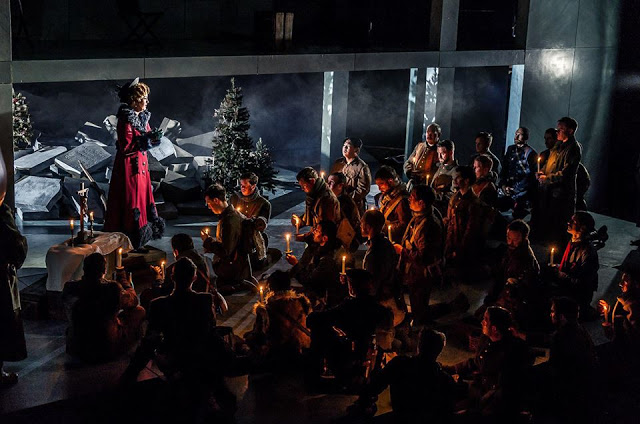They thought they’d be home by Christmas
 |
| Photo: Clive Barker |
By Noel Morris
“Then
Abram bound the youth with belts and straps,
Abram bound the youth with belts and straps,
and
builded parapets and trenches there,
builded parapets and trenches there,
And stretchèd forth the knife to slay his son.
When
lo! an angel called him out of heaven,
lo! an angel called him out of heaven,
Saying,
Lay not thy hand upon lad,
Lay not thy hand upon lad,
Neither
do anything to him. Behold,
do anything to him. Behold,
A ram,
caught in a thicket by its horns;
caught in a thicket by its horns;
Offer
the Ram of Pride instead of him.
the Ram of Pride instead of him.
“But
the old man would not so, but slew his son,
the old man would not so, but slew his son,
And
half the seed of Europe, one by one.”
half the seed of Europe, one by one.”
Those
words were written by Wilfred Owen in “The Parable of the Old Man and the
Young.” Owen, an English poet and World War I soldier, was killed in action Nov.
4, 1918, one week before the Armistice.
words were written by Wilfred Owen in “The Parable of the Old Man and the
Young.” Owen, an English poet and World War I soldier, was killed in action Nov.
4, 1918, one week before the Armistice.
World War I
They thought they’d be home by Christmas. In
August 1914, young men from Austria-Hungary, the United Kingdom, Russia, the
German Empire, France, and other nations flooded recruitment offices. By
December, hundreds of thousands lay dead.
August 1914, young men from Austria-Hungary, the United Kingdom, Russia, the
German Empire, France, and other nations flooded recruitment offices. By
December, hundreds of thousands lay dead.
In four years’ time, the First World War
(1914-1918) snuffed out the lives of some 17 million people, brought down four
empires, and sowed the seeds of World War II. It was a pivotal chapter. At the
beginning of the 20th century, war’s architects deployed cavalry and rifles
with bayonets. By 1918, they used tanks and weapons of mass destruction.
(1914-1918) snuffed out the lives of some 17 million people, brought down four
empires, and sowed the seeds of World War II. It was a pivotal chapter. At the
beginning of the 20th century, war’s architects deployed cavalry and rifles
with bayonets. By 1918, they used tanks and weapons of mass destruction.
People emerged feeling betrayed by the values
of their fathers. Disillusionment displaced romantic notions of valor and
patriotism, hence Hemingway’s epigraph (via Gertrude Stein) calling them the “Lost
Generation.”
of their fathers. Disillusionment displaced romantic notions of valor and
patriotism, hence Hemingway’s epigraph (via Gertrude Stein) calling them the “Lost
Generation.”
Silent
Night
represents an ensemble of these reluctant functionaries, men trapped by the
roles assigned to them by birth and opportunity — cogs in the engine of
Europe’s destruction, and their own.
Night
represents an ensemble of these reluctant functionaries, men trapped by the
roles assigned to them by birth and opportunity — cogs in the engine of
Europe’s destruction, and their own.
The trenches
In September 1914, some 30 miles from Paris,
Allied forces repelled German invaders, pushing them northward. There, both
sides cut trenches into the earth, forming a matched pair of impenetrable
lines. In a series of semicircular maneuvers, each side scrambled to outflank
the other. One would sweep northward, then the other — each time digging in.
Allied forces repelled German invaders, pushing them northward. There, both
sides cut trenches into the earth, forming a matched pair of impenetrable
lines. In a series of semicircular maneuvers, each side scrambled to outflank
the other. One would sweep northward, then the other — each time digging in.
Known to history as “the race to the sea,”
the trenches grew like cracks in the ice until they extended more than 400
miles between the Swiss border and the North Sea (comparable to the distance
between Atlanta and St. Louis). Locked in a stalemate, the military brass
formulated plans for victory by attrition.
the trenches grew like cracks in the ice until they extended more than 400
miles between the Swiss border and the North Sea (comparable to the distance
between Atlanta and St. Louis). Locked in a stalemate, the military brass
formulated plans for victory by attrition.
The rat-infested trenches were incubators for
disease. Under the stench of gunpowder and decaying bodies, soldiers stood for
days in putrid water. Hospital wards swelled with cases of foot infections,
lice-borne “trench fever,” and venereal disease (more than 400,000 cases in the
British army, alone). The space between the trenches was even more deadly. A
tangle of barbed wire, corpses, and upended earth, No Man’s Land, as it was
called, offered a shooting range for enemy snipers.
disease. Under the stench of gunpowder and decaying bodies, soldiers stood for
days in putrid water. Hospital wards swelled with cases of foot infections,
lice-borne “trench fever,” and venereal disease (more than 400,000 cases in the
British army, alone). The space between the trenches was even more deadly. A
tangle of barbed wire, corpses, and upended earth, No Man’s Land, as it was
called, offered a shooting range for enemy snipers.
There was, however, a phenomenon known as
“live and let live.” Between episodes of horrific violence came periods of
boredom. Men noticed a precipitous drop in gunfire during mealtime. Troops
became proactive, with an “if we allow the other guys to eat in peace, they
will return the favor” philosophy.
“live and let live.” Between episodes of horrific violence came periods of
boredom. Men noticed a precipitous drop in gunfire during mealtime. Troops
became proactive, with an “if we allow the other guys to eat in peace, they
will return the favor” philosophy.
In this way, the two sides brokered slightly
less belligerent positions. Similar rules applied to latrines and even chance
encounters in No Man’s Land. Holding up signs, throwing stones with messages
attached, calling out, and in-person meetings became viable methods
for negotiating terms of engagement.
less belligerent positions. Similar rules applied to latrines and even chance
encounters in No Man’s Land. Holding up signs, throwing stones with messages
attached, calling out, and in-person meetings became viable methods
for negotiating terms of engagement.
Confusion
World War I alliances, as they existed in
August 1914, belied the tangle of relationships between peoples. Germany’s Kaiser
Wilhelm II, the Russian Czar Nicholas II, and Britain’s George V were all first
cousins, grandsons of Queen Victoria.
August 1914, belied the tangle of relationships between peoples. Germany’s Kaiser
Wilhelm II, the Russian Czar Nicholas II, and Britain’s George V were all first
cousins, grandsons of Queen Victoria.
Cross-border interactions between French,
German, and British citizens had been common in peacetime; in wartime,
antipathy between French and British soldiers — allies — was widespread. To
further confuse matters, civilian populations were bombarded with wartime
propaganda.
German, and British citizens had been common in peacetime; in wartime,
antipathy between French and British soldiers — allies — was widespread. To
further confuse matters, civilian populations were bombarded with wartime
propaganda.
One British soldier wrote: “At home one
abuses the enemy and draws insulting caricatures. How tired I am of grotesque
Kaisers. Out here, one can respect a brave, skillful, and resourceful enemy.
They have people they love at home, they too have to endure mud, rain, and
steel.”
abuses the enemy and draws insulting caricatures. How tired I am of grotesque
Kaisers. Out here, one can respect a brave, skillful, and resourceful enemy.
They have people they love at home, they too have to endure mud, rain, and
steel.”
Silent Night throws a
cross-section of society into the trenches: a general’s son, a singer, farm
boys, and members of the working class. It’s the people we cannot see, the
heads of state, the “fat old men … swigging their champagne,” according to the
character named Nikolas Sprink, who are the real villains.
cross-section of society into the trenches: a general’s son, a singer, farm
boys, and members of the working class. It’s the people we cannot see, the
heads of state, the “fat old men … swigging their champagne,” according to the
character named Nikolas Sprink, who are the real villains.
Sprink, a professional opera singer, is the
first to show symptoms of Gertrude Stein’s “Lost Generation.” He sings:
first to show symptoms of Gertrude Stein’s “Lost Generation.” He sings:
“My Anna,
I cannot go back
to my life before.
I cannot.
I have seen too much.
I know too much. Everything is useless. All of it:
Opera, singing, useless.”
I cannot go back
to my life before.
I cannot.
I have seen too much.
I know too much. Everything is useless. All of it:
Opera, singing, useless.”
The Christmas Truce
Silent
Night,
which won a 2012 Pulitzer Prize for Kevin Puts’ music, is based on real-life
accounts of spontaneous ceasefires along the front lines at Christmastime 1914.
Night,
which won a 2012 Pulitzer Prize for Kevin Puts’ music, is based on real-life
accounts of spontaneous ceasefires along the front lines at Christmastime 1914.
The story, commissioned by the Minnesota
Opera, came to librettist Mark Campbell via Christian Carion’s Academy
Award-nominated film Joyeux Noël. In
the opera, composer Puts uses the relationship between dissonance and tonality
as an allegory for war and peace.
Opera, came to librettist Mark Campbell via Christian Carion’s Academy
Award-nominated film Joyeux Noël. In
the opera, composer Puts uses the relationship between dissonance and tonality
as an allegory for war and peace.
In the opening scenes, the armies sing their
national songs at one another, creating a cacophony that advances the fighting
where stage combat leaves off. In Act 2, as the enemies begin to come together,
so does their music.
national songs at one another, creating a cacophony that advances the fighting
where stage combat leaves off. In Act 2, as the enemies begin to come together,
so does their music.
Silent
Night’s
story pivots around an act of pure madness: Sprink climbs upon the parapet to
sing Christmas carols with the enemy. A laying down of arms follows, with
soldiers exchanging cigars, whiskey, champagne, and chocolate. Together, they
share family photos, kneel in worship, and bury their dead side-by-side.
Night’s
story pivots around an act of pure madness: Sprink climbs upon the parapet to
sing Christmas carols with the enemy. A laying down of arms follows, with
soldiers exchanging cigars, whiskey, champagne, and chocolate. Together, they
share family photos, kneel in worship, and bury their dead side-by-side.
Like Amadeus
or Romeo and Juliet, Silent Night is a tale that teases the
audience with hope. We look for a different outcome, even though we know better.
The generous spirit that silences guns on Christmas Eve cannot overcome the
weight of history. By opera’s end, the “fat old men” restore order among the
ranks, and the warriors fight on.
or Romeo and Juliet, Silent Night is a tale that teases the
audience with hope. We look for a different outcome, even though we know better.
The generous spirit that silences guns on Christmas Eve cannot overcome the
weight of history. By opera’s end, the “fat old men” restore order among the
ranks, and the warriors fight on.


